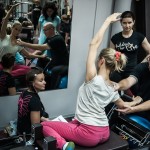Cueing Efficient Movement – by Brent Anderson PhD, PT, OCS, PMA®-CPT
The topic of cueing movement and coaching has been of deep interest to me for years. Many years ago, coming from a fitness and sport background, we thought of all movement coming from the muscles. So, we taught movement by teaching muscles to contract. We tried to be smarter than the muscle and the nervous system, telling muscles when and how much to contract. I realized a long time ago that this method of teaching movement was not effective and definitely not efficient. Don’t get me wrong, after nearly 30 years of teaching qualitative movement as a physical therapist, I know all of the muscles and bones in the body and I know what theoretically they are supposed to do, but that doesn’t help me in coaching movement. If we think about it, members of the animal kingdom do not have to think about running across the Sahara or climbing trees, they do it automatically. Your dog doesn’t get up and stretch before chasing the mailman, and your cat doesn’t strengthen its glutes before jumping up on the counter. Likewise, a child does not think about recruiting their abdominal wall and pelvic floor every time they pick up a toy, actually never. So where did we make the switch between spontaneous movement and isolated muscle training?
I have been accused at times of being anti-muscle training. It is actually quite the opposite, I am so impressed with how the body naturally organizes for movement. As Blandine Calais-Germain says about breath, “complex movement requires spontaneous breath” and “the more complex the movement the more spontaneous the neuromuscular organization needs to be”. We apply this notion to the body’s ability to organize its neuromuscular system.
I believe the best way to teach efficient movement is to align the structure of the body with the proper load and velocity of the desired activity – anticipation is key.

